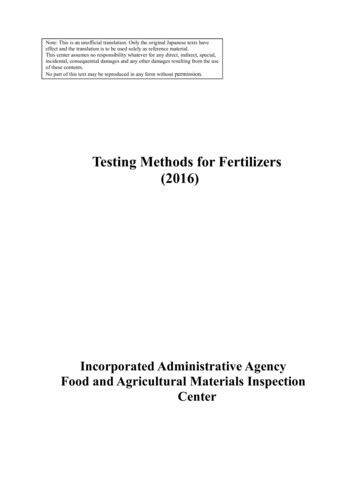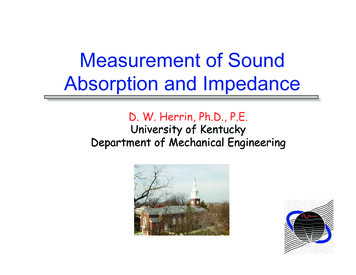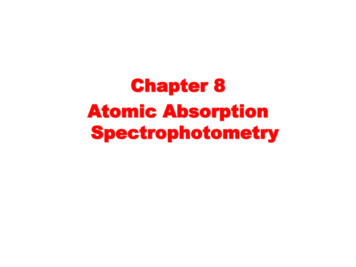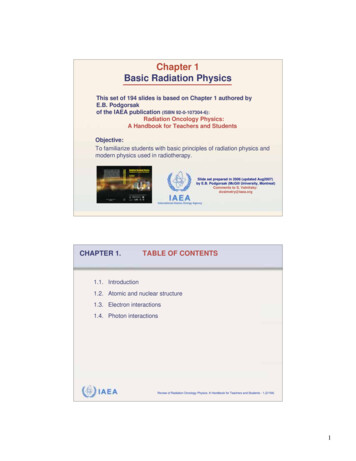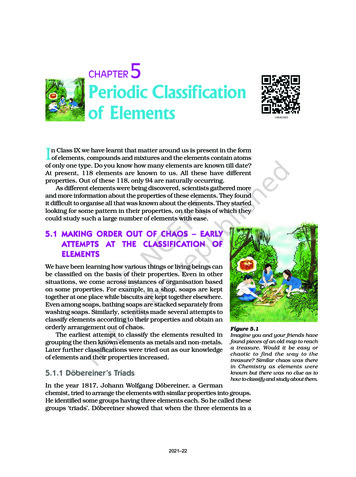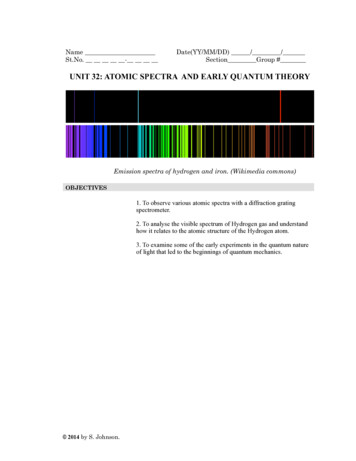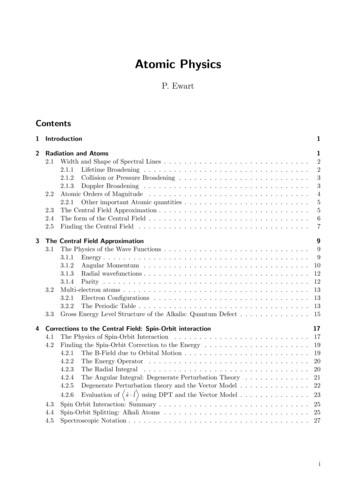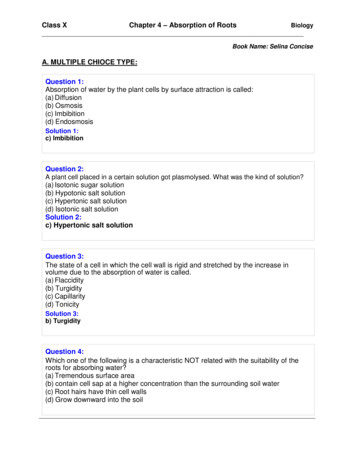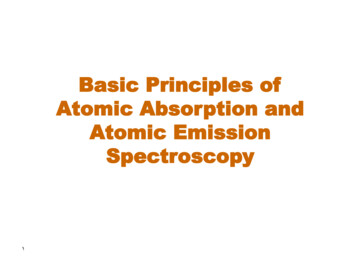
Transcription
Basic Principles ofAtomic Absorption andAtomic EmissionSpectroscopy1
Flame Atomic Emission SpectrometerPSourceSample2Wavelength SelectorDetectorSignal ProcessorReadout
Flame Atomic Emission Spectrometer3
Emission TechniquesTypeArcSparkFlameArgonplasma4Method of Atomization Radiation Sourcesample heated in ansampleelectric arc (4000-5000oC)sample excited in asamplehigh voltage sparksample solutionaspirated into a flame(1700 – 3200 oC)sample heated in anargon plasma (4000-6000oC)samplesample
Emission SpectroscopyFlame and Plasma Emission Spectroscopy are based upon thoseparticles that are electronically excited in the medium.The Functions of Flame and Plasma1. To convert the constituents of liquid sample into the vaporstate.2. To decompose the constituents into atoms or simple molecules:M e- (from flame) - M hn3. To electronically excite a fraction of the resulting atomic ormolecular speciesM - M*5
Emission SpectroscopyMeasure the intensity of emitted radiationExc ited StateEmits SpecialElectromagnetic Radiation6Ground State
7
Argon Inductively Coupled Plasma as anatomization source for emission spectroscopy8
9
Why plasma source or other highenergetic sources? Flame techniques are limited to alkali (Li, Na, K, Cs,Rb) and some alkaline earth metals (Ca and Mg) More energetic sources are used for– more elements specially transition elements– simultaneous multielement analysis since spectraod dozen of elements can be recordedsimultaneously– Interelement interference is eliminated– Liquids and solids10
Advantages and disadvantages ofemission spectrometryAdvantages rapid Multielement (limited for alkali and some alkaline earthmetals ICP-AES has become the technique of choice for metalsanalysis.Disadvantages initial cost of ICP instrumentation continuing cost of operation (Ar required)11
Flame Atomic Absorption SpectrometerPoPSourceWavelength SelectorChopperSample12DetectorSignal ProcessorReadout
Flame Atomic Absorption SpectrometerT13
Atomization TechniquesTypeAtomic(flame)Method of Atomization Radiation Sourcesample solution aspiratedHCLinto a flameatomicsample solution evaporated(nonflame) & ignited (2000 -3000 oC)(Electrothermal)HCLHydridegenerationVapor hydride generatedHCLCold vaporCold vapor generated (Hg)HCL14
Advantages and disadvantages of atomicabsorptionAdvantages sensitive (GFAA)selectiveDisadvantages intended for metallic/metalloid atomic species, notnonmetals or intact molecular species lamps - one element at a time not easy for solids calibration curves nonlinear above A 0.5 more costly and less widely applicable than UV vis matrix effects - easy for some metals to be masked15
16
Flame Fluorescence SpectrometerPoPWavelength Selector90oSourceSample17DetectorSignal ProcessorReadout
Fluorescence uoresence18Method of Atomizationsample soln. aspiratedinto a flamesample soln. evaporated& ignitednone requiredRadiation Sourcesamplesamplesample
Processes that take placein flame or plasma19T1
FlamesRegions in Flame20Temperature Profile
21
22
23
24
25
26
Flameless atomizationElectrothermal atomizationGraphite furnace atomization27
28
29
30
Why do we use a temperature program inflameless AA?31
Why do we use an inert gas withFlameless atomization?32
Light source used for AA What light source do we use with AA? Would it be a continuous light source or aline light source? A line light source is used for AA33
T234
35
How does the line sourceprovide a single wavelenght?T336
37
38
AA spectrophotometer39
40
41
42
43
Relationship Between Atomic Absorption andFlame Emission Spectroscopy Flame Emission - it measures the radiation emitted by theexcited atoms that is related to concentration. Atomic Absorption - it measures the radiation absorbed by theunexcited atoms that are determined. Atomic absorption depends only upon the number of unexcitedatoms, the absorption intensity is not directly affected by thetemperature of the flame. The flame emission intensity in contrast, being dependent uponthe number of excited atoms, is greatly influenced bytemperature variations.44
Measured signal and analytical concentration1.Atomic EmissionSignal Intensity of emission KNf K’Na K’’CNf number of free atoms in flameNa number of absorbing atoms in flameC concentration of analyte in the sampleK, K and K’’ depend upon: Rate of aspiration (nebulizer) Efficiency of aspiration (evaporation efficiency)––– Efficiency of atomization (effect of chemical environment).This depends upon–––– 45Flow rate of solutionSolution concentrationFlow rate of unburnt gas into flameDroplet sizeSample flow rateRefractory oxide formationRatio of fuel/oxygen in flameTemperature effect (choice of flame temperature)
2. Atomic absorptionSignal I absorbed Absorbance A k l C For the measurement to be reliable k mustbe constant; k should not change when achange in matrix or flame type takes place. K depends upon same factors as thosefor the atomic emission spectroscopy46
Background andBackground Correction47
Definition Sources of Background Background correction:– Blank correction method– Two-line correction method– Continuous source correctionmethod– Zeeman effect correction method48
What is a background? It is the signal observed when the element sought isabsent The light at a specific wavelength (Analyte wavelength) isattenuated by the effect of flame components or matrixcomponents in the sample Thus measured absorbance and analyte concentrations aretoo high If problem from flame, blank aspiration will correct for it It is more serious at short wavelengths ( 430 nm) and withgraphite furnace49
Sources of Background in atomicabsorption1. Absorption by flame itself (Serious at below 220 nm; e.g., As, Se, Zn ) Water blank can compensate for this flameabsorption In flame absorption, backgroundinterference is insignificant at 230 nm50
2. Absorption by concomitant molecular species originatingfrom the matrix like NaX or solvents containing X(halogen) like CCl4. Halides absorb at 300 nm3. Scattering of radiation from the particulate material in theflame Particulate material: Unevaporated droplets;unevaporated refractory salt particles Scattering is more serious at short 2 and 3 are most common with electrothermal atomizer51
Specific Applications Requirebackground correction1. Graphite furnace2. Flame determination of low concentrations of an elementin the presence of high concentrations of dissolved salts3. Flame analysis where sample matrix may show molecularabsorption at of the resonance line4. Flame determination of an element at where flameabsorption is high52
Background correction methods1. Using a blank Measure the absorbance of the metalresonance line by both flame & blank(flame system) Measure the absorbance of the metalresonance line by sample and flame system(flame blank) A is the difference53
The main two methods used for background correction:1. Continuous source correction method2. Zeeman effect correction method These two methods are based on the fact that Atomic bands are very narrow Background bands are molecular in nature thusthey are broad bands54
2. The continuous-source correctionmethod This method is an available option with mostinstruments Deuterium lamp is used in conjunction with the HCLlamp The two lamps are observed by detectoralternatively in time Background usually absorb radiation from D2 lampand HCL Absorption of the analyte from D2 lamp is negligible The lamps may be pulsed at different frequencies,thus the signal processing electronics candistinguish and process separate absorption signals ThusAcorrected A HCL - AD255
The continuous-source correction methodChopper56
57
Background correction by continuous sourcecorrection methodHCLHCLHCL58
59
60Disadvantages of the continuous sourcecorrection methodCorrection may degrade detection limit. Thecurrent of HCL is reduced to match the D2lampThe correction may be in error if thebackground s (sample and standards) arenot the sameAlignment of the two sources to passthrough the same area of atomizer is tediousBeam splitter reduces the intensity ofradiation which may affect the limit ofdetectionAdditional light source and electronics areneeded
Zeeman effect correction method61
Zeeman effect correction method62
Under the magnetic field, atomic spectral line(emitted or absorbed) splits into three ormore polarized components Two components will be displaced at equalwavelength intervals higher and lower thanthe original line. The original line is polarized in plane parallelto the magnetic field and the other lines arepolarized perpendicular to the magnetic field The original line is absorbed by bothbackground and analyte. However, the otherlines are absorbed by background only The signal corresponding to the analyte isthe difference63
Advantages of Zeeman method Only a single lamp is required Problems of alignment of two beams iseliminated It provides more accurate correction forbackground than other methodsbecause the background absorbance ismeasured at or very near thewavelength that the analyte absorbanceis measured64
Disadvantages of Zeeman method The implementation is rather complex andexpensive The original and the split bands may overlapcausing an increase in the background signal This causes a curvature in the calibration curve The instrument is bulky because of the magnet Spectral lines for some elements may undergomore complex splitting. Thus sensitivity will bereduced (It gave good results for 44 elements) It is more difficult to engineer with flames65
Source self reversalbackground correction method It is based on self-reversal of the HCL spectral linesat high current At high current, many free atoms are generatedcausing an increase in the number of unexcitedatoms that absorb the center of the emitted linecausing the self reversal Specially good for correcting for high molecularabsorption for that by phosphate on Se and As A total is measure66
Hollow cathode lamps normally operate atcurrents of 3-15 mA. If the applied power is raised to several hundredmA, they exhibit a phenomenon called selfreversal. This giant pulse of current changes the nature ofthe analyte absorption line so it will only measurethe background absorbance. Atotal is measured during the low current period.Abackground is measured during the high currentperiod The low current (6-20 mA) is pulsed at 100-500mACorrected signal Signal before the pulse–Signal After the pulse67
Advantages of Smith-Hieftje technique Only a single source is used It offers all the advantages of other methodsat low cost It does not lose radiation like in Zeeman butthis mehtod with the Zeeman one are lesssensitive than the D2 one Drawbacks– less sensitivity– lamp life decreased68
Background in atomic emission Sources1. Emission from flame2. Emission from the sample matrix69
Electrothermal Atomizer(Graphite Furnace) Main components Atomization steps Interferences and matrix modification70
Graphite Furnace Atomic AbsorptionSpectrometry, GFAAS A technique to minimize dilution during atomizationof the analyte prior to its determination with atomicabsorption spectrometry A technique with more interferences than the morereliable flame atomization A technique with high sensitivity and very gooddetectability but not so good throughput andprecision71
Advantages of GFAS Increase in the residence time thusmore sensitivity will be obtained Possibility of analyzing samples ofvarious matrices Analyzing small size samples even onthe microliter scale Avoiding the formation of refractoryoxides that cause serious interferencesourcse72
Minimize73the surface adsorption
Why do we use an inert gas with GFAAS?74
Atomization Process75
Steps in graphite furnace atomization The steps of a GF atomization 5-100µl sample– drying– ashing– atomization– burnout– cool76
Steps in GF atomization The sample introduction– The sample is injected, usuallybetween 10-30µl but sometimes therange could be extended to 100µl.– The solution is preferably made up ofdilute nitric acid as matrix– sometimes solid samples areintroduced77
The drying step– to volatilize the sample solvent– use some degrees above the solventsboiling point (for water use 110 C) andabout the same time in seconds as theinjected volume in µl– check that the solvent only volatilizesand not boil, otherwise badreproducibility may occur78
Ashing of the sample– Maybe the most important step– Remove sample matrix without losing theanalyte– Highly dependent on both the analyte andsample matrix– Conditions for every new sample typeshould be optimized– Inorganic matrix more difficult, becausehigher temperatures are needed79
The atomization step– This step is to vaporize and atomize theanalyte– the vaporization pressure of the analytedominate the supply of analyte atomsinside the tube– The convection of expanding gas anddiffusion dominate the transport ofanalytes out of the tube– rapid heating is necessary for goodsensitivity80
The burnout step– it is used for taking away parts of thesample not completely volatilized duringatomization– temperatures in the range 2700-3000 C ismost often used– if vaporization of the sample is achieved,completely, the sensitivity will slowlydecrease and the imprecision increase Cooling step– its purpose is to cool down the furnacebefore next sample is added81
Steps in GF atomizationtemperature progamme3000Temp ( C)25002000Atomization15001000Ashing500Dryingtime (sec)008220406080
Interferences with graphite furnaceand its control In the early days this technique wasaccepted as a highly interferencetechnique Later, new instrumental and analyticalprocedures were developed whichavoided the conditions found to be thesource of interference problems83
Interferences in GFAAS The graphite furnace atomization technique is muchmore affected by interferences than the flame whichdepends on higher concentrations of non-analytes–physical change in surface properties of the graphite tubeinfluences the atomization rate–Spectral molecular absorption by molecules or atoms otherthan the analyte atoms light scattering–non spectral or chemical molecular binding between analyte and matrix formation of less volatile compound reactions with the graphite tube84
Interference removalSpectral interferences Emission interference Non-analyte absorption and scattering85
1. Emission interference Radiation emitted by the hot graphite tube orplatform that covers a wide range ofwaqvelengths (250-800 nm) Following elements will be obscured:– Zn 213.9 nm; might be ok– Cr 357.9 nm– Ca 422.7 nm– Ba 553.7 nm mostly affected This effect is eliminated by removing thegraphite tube wall or platform from the viewof the detector. This is achieved by ine of the86following arrangements:
Setting a narrow monochromator slit Furnace alignment Cleaning graphite tube and windows toprevent light scattering Atomization temperature should not behigher than required87
2. Non-analyte absorption and scattering It is considered as a background absorption It is the most severe spectral interferenceproblem It occurs as a non specific attenuation of light atthe analyte wavelength due to matrixcomponents in the sample It leads to having a broad band covering 10100’s nm due to molecular absorption caused by“undissociated sample matrix” components inthe light path at atomizationRemedy? Matrix modification Furnace control procedures 88Background correction as with flame techniques
Matrix modification Matrix should be more volatile than the anayte so asto be removed before atomization1. Formation of easily volatile matrix components, e.g.,Using NH4NO3 or ammonium acetate to modify NaClmatrixNaCl NH4NO3NaNO3 NH4Clnonvolatile matrixMatrixmodifierMore volatile compounds The more volatile components can be driven off atlower pyrolysis temperature89
2. Converting the analyte element into a lessvolatile (if it is too volatile) component usinga modifier e.g., Ni (NO3)2 for Sedetermination. Se is a highly volatile component With the modifier Se form nickel selenide.Thus, Se can be heated up to 900 oC withoutloss. Consequently the matrix would beremoved without affecting Se.90
3. Varying the sample volume Can be done if concentration allows Reduce the sample size by injecting smallersamples, thus the mass of background producingmatrix components will be reduced.4. Spectral background correction A continuous background correction is not veryefficient specially for complex matrices. Matrixmodification is a must. Zeeman background correction is very efficient forcomplex matrices91
Chemical Interference It occurs when other components of the samplematrix inhibit the formation of free analyte atomsM o XoFree analyte atoms92MXDifferent matrix component
Interference Removal1. Ashing with the optimal temperature–matrix modification (mentioned above) Delay of anayte release to furnace allows time for aconstant furnace temperature thermal stabilization of analyte (to hold the analyteon the graphite surface to a higher temperature)and vaporization of interference during the ashingstep– Thus, volatility of interfering matrix compoundis increased On the other hand volatility of interferingcompound is decreased and selective vaporizationduring the atomization steptakes place93
2. Use of pyrolytically coated Tubes and Platforms Ordinary graphite has a porous surface thus it formswith the analyte a carbide that is nonvolatie The tubes are more or less always fabricated frompyrolytic carbon or covered with a pyrolytic carbon layer.It’s a more inert form of the graphite. It is more densesurface and less absorption Tubes could sometimes be coated with tungsten ortantalum for prolonged lifetime or other specialapplications The platform technique is used to vaporize the analyteinto a more uniform and higher temperature than therelease from the wall. The analyte vaporizes after thetubewall and gas phase reach a steady state94
L'vov Platform – Thin graphite plate inserted intotube with flat trough– L'vov barely contacts sides of tube– Sample is heated more uniformly by air– Platform delays the appearance of analyte untilthe furnace has reached atomization temp95
Functions of the platform It resists tndency for sample to saok into surfacebefore or during drying It tolerates high acid concnetration It gives bigger signal and less background– It is heated gradually by radiation from walls– When atomization step is reached the temperature ofthe sample and furnace environment will be similar– No chance for sudden cooling and recombinationforming molecular species inhibiting atomizationI96
Disadvantages of Graphite Furnace Prone to interferences, poor precision Must take Step to control Precision:1. Autosamplers vs. Manual Injection - more precise2. Duplicate analyses for all samples (repeat if pooragreement)3. Standard addition method - making standards up insample4. Background correction for Molecular Absorption)1. D22. Zeeman Background Correction3. Matrix Modifiers to controlatomization97
INDUCTIVELY COUPLEDPLASMA 98Main components of the instrumentPerformance of ICPICP-mass spectrometryinterferences
Introduction The device which produces the ICP is commonlyreferred to as the ICP torch. It consists of two to fourArgon flows depending on the manufacturer: Nebulizer gas (inner Argon flow), at about1 L/min, carries the analyte aerosol Sheath gas for producing a laminar flow toimprove low excitation energy elements eg groupI & II elements Auxiliary gas (if present), lifts the plasma abovethe injector tube, used when measuring organics Plasma gas, at about 12-16 L/min, sets theplasma conditions, e.g., excitation temperature99
Sample Introduction An ICP-AES instrument consists of a sampledelivery system, an IC plasma to generate the signal,one or more optical spectrometers to measure thesignal, and a computer for controlling the analysis. The most common sample delivery system consistsof a peristaltic pump and capillary tube to deliver aconstant flow of analyte liquid into a nebulizer.100
Inductively Coupled Plasma Torch101
How does plasma generate? RF induction coil powered by RF generatorwill generate a fluctuating magnetic fieldaround the coil Ionization of Ar is initiated by a spark Ar and e- will interact with the magnetic fieldthus they will be forced to move in annularpaths Omic heating is the result of their resistanceto the forced movement in limited area102
Inductively Coupled PlasmaEmission Source103
Inductively Coupled PlasmaEmission Source and Supply104
105
106
An ICP torch can be used to atomize andionize materials for quantitative trace andultratrace elemental analysis The compounds in the samples are brokendown into their elemental form and somefraction of each elemental species issimultaneously ionized The monocationic ( 1) form is preferredfor the assay, and conditions are set toenhance production of that form The torch is normally operated at atemperature of 3000K107
Schematic diagram of a typical ICP-OES instrument108
Schematic diagram showing the differentregions in the IC Plasma109
Processes that take place in the plasma Aerosol vapor is transported to the plasma Vapor desolvates Atomization occurs within the plasma Atoms get excited to atomic and ionic states Rich spectra produced because of presence of bothatomic and ionic lines Because of their different excitation energies,different emission lines will have maximum intensitiesat different vertical positions in the plasma110
Typical detection limits in ICP-OES111
112
Typical detection limits in ICP-OES113
SamplingLiquids Form an aerosol ( 5 µ droplet size) of the liquidsample Eliminate larger droplets The use of liquids facilitates automatic sampling:Gases May use gasses directly or indirectly, e.g., formhydridesSolids May use slurries (if 95% of particles 5 µ) May use spark ablation or laser ablation to generatea small metal vapor114
Viewing position The plasma generated in an ICP can be viewedby the spectrometer, side-on or end-on. These viewing positions are called radial andaxial viewing, respectively. Each has advantages and disadvantages, soeach tends to be used for different applications:radial viewing for normal analysis and complexmaterials, axial viewing for low detection limitsin simpler materials.115
116
Advantages of Radial View Should collect signal from the entire normalanalytical zone– no torch adjustment for different elements– fewer matrix effects and interferences, especially inorganics– less stray light– better detection limits in difficult matrices, especiallyin alkalis and organics– can run any matrix– less maintenance of the torch– torches last longer especially with dissolved salts– lower consumption of argon117
118Advantages of Axial View: More intensity Better detection limits in simple matrices
RF-Generator ICP's generally require an RF power of 1-2 kW maximum outputto maintain the plasma. High efficiency required - especially for organics (not less than1.5 Kw)Frequency Fixed versus Free Running– Fixed: Crystal controlled, eg at 40 MHz– Free running: floats eg at 40 MHz 2 MHz 40 MHz versus 27 MHz– Because of the skin-effect in RF plasmas, higherfrequency gives a thinner plasma with a widerdynamic range (less self-absorption), with lowerbackgrounds and fewer interferences.119
120
90% element coverage 0.1 to 10 ppb sensitivity for mostelements RSD 2% to 4%121
Typical laser ablation/ICP-MS mass spectrum of a rock sample122
Comparison of Detection LimitsBlack ICP/MS Cross-Hatch ICP/AES123Gray Furnance AA
Comparison of ICP/AES & ICP/MS for the analysis ofCerium solutionsICP/AES (100 ppm Ce)Background ionsoriginated fromthe Ar, O, H andN elementsICP/MS (10 ppm Ce) Simple to interpret, especiallyfor rare elements Less interference fromatmospheric contaminants ormolecular bandsNitric acid is commonly used as acidification agent rather than hydrochloric acid, sulfuric acid andphosphoric acid in sample preparation. Why?124
Limitations for ICP/MS Quantitation Formation of monocationic ions, doubly-charged ionsand stable metal oxides ions in the torch depends onthe identity of the element and several experimentalconditions, such as the plasma r.f. power and thenebulizer gas flow rate. Spectroscopic interference:1. Isobaric Interference- isotopes of different elements (or isobaricinterference) e.g. 87Rb and 87Sr ; 40Ar and40Ca ; 58Ni and 58Fe 125
– Polyatomic Ion Interference interactions between species in the plasmaand species in the matrix or atmosphere, e.g.molecular ions from the acids of digestione.g. ClO and 51V Which element(s) does not have isobaricinterference caused by the presence of otherelements?126
Matrix effect:(a)Limited tolerance for salt concentration( 1% is acceptable but 0.1% is preferred!)– The deposition of salts leads to adecrease in the aperture diameter, so thesensitivity worsens and the signalgradually decreases as a function of time(b)Organic solvents tend to quench the plasmatorch127
Approaches to reduce the occurrence ofpolyatomic interferences Adjust the plasma conditions to minimize the formation ofpolyatomic speciese.g. use 5-10% N2 in Ar, the axial temperature of the plasmaincreases by 1000 Kand the electron density increases by30%. A marked reduction of MO ions Minimizing the amount of water vapor introduced into theplasma in order to limit the signal intensity of oxygencontaining speciese.g. reduce the spray chamber temperature(?) Use He instead of Ar as plasma gas to avoid interference frompolyatomic ions containing argon Use electrothermal volatilization for sample introduction 128Use high resolution ICP/MS
Approaches to correct for or overcomematrix effect Dilution Matrix matching Use of internal standards– Additionof a known and preferably an equalconcentration of an internal standard to all samples (&standards). The analytical signal is taken as the ratio ofthe signals for the analyte elements in the sample (&standards) and the signal for the internal standard Standard addition– A known amount of the element(s) of interest is added tothe sample and hence suffers the same matrix effect asthe analyte129
1. Atomic Emission Signal Intensity of emission KN f K'N a K''C N f number of free atoms in flame N a number of absorbing atoms in flame C concentration of analyte in the sample K, K and K'' depend upon: Rate of aspiration (nebulizer) Efficiency of aspiration (evaporation efficiency) - Flow rate of solution
